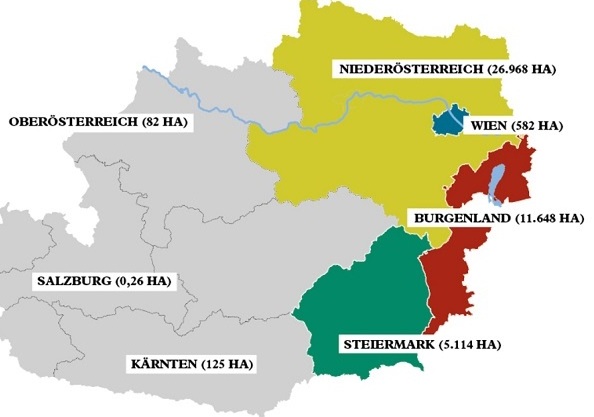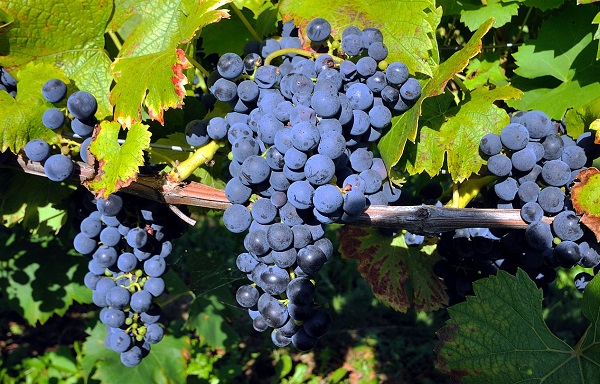Blauburgunder Aromas
Cherries and wild berries are the most common Blauburgunder aromas, with hints of herbs, flowers, mushroom, and soil.
Red Cherry |
Strawberry |
Raspberry |
Cranberry |
Black Cherry |
Blueberry |
Blackberry |
Black Currant |
Herbs |
Spices |
Mushroom |
Violet |
Blauburgunder in Austria
Pinot Noir is known as Blauburgunder (Blue Burgundy) in Austria.
Blauburgunder wines are similar in character to Pinot Noir wines from Burgundy.
If aged, French barrels (barriques) are most often used.
Blauburgunder is a lot of quality for the money. Try it with a schnitzel!
- Niederösterreich 304 hectares (50%)
- Burgenland 241 ha (40%)
- Steiermark 22 ha (4%)
- Wien 19 ha (3%)
Austrian Pinot Noir
Some of the best Austrian Pinots come from the Neusiedlersee and Blaufraenkischland in Burgenland, and the Thermenregion in Niederösterreich (Lower Austria).

Spätburgunder in Germany
In Germany, Pinot Noir (Spätburgunder) is the most planted red wine grape.
Spätburgunder wines are similar in character to Pinot Noir wines from Burgundy, and if aged, French barrels (barriques) are most often used.
The German climate is good for producing Pinot Noir. It is grown in all wine regions, but the primary areas are Ahr, Baden, and Pfalz.
Ahr is a small, northerly region is highly regarded for its Pinot Noir, with many vineyards on steep slopes that benefit from ample sunlight.
Baden is the largest Pinot Noir producer in Germany, known for its volcanic soils and limestone-based wines.
Pfalz produces notable Pinot Noirs.
Rheingau is known for its Riesling, but also has meny small vineyards dedicated to Spätburgunder.
In Germany there is also a smaller, early ripening, variety called Frühburgunder ("Early Burgundian") which is grown in Rheinhessen and Ahr.

Pinor Noir Vinification
Pinot Noir can be vinified into red, rosé and sparkling wines.
Pinot Noir the most planted grape in the Champagne region in France, where Chardonnay and Pinot Noir are the major ingredients in many Champagne wines, especially in Blanc de Noir which means white (wine) made from 100% black (grapes).
Champagne producers press the skin off the grapes right away to not retain color and tannins. By quickly separating the skins from the juice you prevent the black pigment to be transferred to the wine.
Some producers make Pinot Noir with a technique called "Whole Cluster Fermentation", where the entire grape bunch, including the stems, goes into the fermentation. This adds extra tannins to the wine.
Pinot Noir DNA
Pinot Noir is believed to be a very old grape. It existed for at least 2000 years.
Probably due to this longevity, Pinot Noir is particularly prone to mutations and there are hundreds of different clones worldwide.
Pinot Noir (Pinot Nero in Italy), Pinot Blanc, Pinot Meunier, Pinot Précoce (Frühburgunder) and Pinot Gris are mutations of the same "Pinot" variety.
Pinot Noir is the parent of grape varieties such Gamay, Aligoté, Gouais Blanc and Chardonnay.
Pinot Noir Terroir
Pinot Noir is a World Classic. It is one of the most cultivated grapes in the world. and famous for its ability of interpreting the terroir.
Pinot Noir likes the limestone soils of Burgundy.
This limestone originated in the tropical sea that covered Burgundy 150 million years ago. In fact you can still find many shell fossils.
The hills which stretch from Chablis to Mâconnais, while passing the Côte de Nuits, the Côte de Beaune and the Côte Chalonnaise, were created and shaped by the formation of the Alps and the glacial periods which followed.
Burgundy’s subsoil is primarily composed of marl and limestone of Jurassic marine origin.
All the red Burgundy Grands Crus are located on the Côte de Nuits, except Corton Grand Cru, the only one which is located on the Côte de Beaune.
In Burgundy, when we talk about "climat", we do not raise our eyes to the sky, we drop them on the ground. (Bernard Pivot, writer).
Climat is a parcel of vineyard, carefully delimited and named, which has a long history and special geological and climatic conditions. Each wine from a "climat" has its taste and its place in the hierarchy of wines (Regional Appellation, Village, Premier Cru, Grand Cru).
The Climats are over 1000 and the most famous are: Chambertin, Romanée-Conti, Clos de Vougeot, Montrachet, Corton, Musigny.
Clos is a Climat surrounded by walls. In the Middle Ages a "clos" belonged to a monastery or a rich family.
